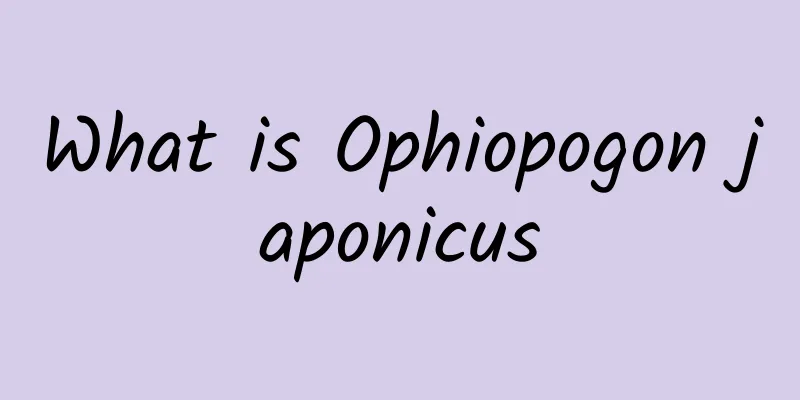What is Ophiopogon japonicus

|
Ophiopogon japonicus is the tuberous root of the Liliaceae plant Ophiopogon japonicus. It is slightly sweet and bitter in taste and cold in nature. Sweet, slightly bitter, cold. Enters the lung, stomach and heart meridians. It can nourish yin and clear away heat to treat yin deficiency, internal heat or heat disease causing damage to body fluid, irritability and thirst. Moistening the lungs and relieving cough can treat cough, thick phlegm and qi reversal caused by dryness and heat damaging the lungs. This product is sweet, cold and refreshing. It is good at clearing heat from the heart and lungs, nourishing yin and relieving restlessness. It can also clear the stomach and intestines, quench thirst and relieve dryness. Anti-experimental arrhythmia, increase coronary blood flow. Ophiopogon japonicus has good safety in clinical use, and animal subacute toxicity experiments have shown that the drug has low toxicity. A perennial herb of the Liliaceae family, growing in clumps, about 30 cm high. The leaves are clustered, slender, dark green, and shaped like leeks. The flower stalks grow from the leaves, and the flowers are small, lavender, and form racemes. The fruit is a berry, spherical in shape, dark green or black-blue when ripe. The rhizome is short with many fibrous roots. The middle or tip of some of the fibrous roots are often enlarged into spindle-shaped fleshy tubers, which are the medicinal Ophiopogon japonicus. Ophiopogon japonicus: It is the tuberous root of the plant Ophiopogon japonicus of the Liliaceae family. The commonly used clinical products are divided into those with the core removed and those with the core not removed. The idea of removing the core was first seen in Tao Hongjing's "Famous Doctors' Records", which said that Ophiopogon japonicus can make people upset if the core is not removed. There were many opponents among later medical practitioners. For example, Wu Jutong would always note that the heart of Ophiopogon japonicus should not be removed, saying that the heart of Ophiopogon japonicus can enter the heart and directly clear the heat of the heart meridian. The author believes that there is no need for debate, as medication habits vary from place to place in China, so we can adapt to local customs and do not need to be too demanding. If you want to use it to enter the heart and clear away heat, you can mix it with cinnabar, which is called Chen Maidong. To clear and nourish the yin of the lungs and stomach, it is mostly used without the heart, while to nourish yin and clear the heart, it is mostly used including the heart. Note that Ophiopogon japonicus is cold in nature and moist in nature, and has a good effect of nourishing yin and moistening dryness. It is suitable for symptoms of yin deficiency, internal heat, dry cough and lack of body fluid. It should not be used for symptoms of water dampness, cold dampness, phlegm turbidity and obvious qi deficiency caused by spleen deficiency and dysfunction of transportation and transformation. When using Ophiopogon japonicus as a tonic to replenish deficiency in clinical practice, attention should be paid to syndrome differentiation. Improper use will cause dampness and phlegm, and lead to adverse reactions such as excessive phlegm, dry mouth, and poor appetite. |
<<: Medicinal value of Ophiopogon japonicus
Recommend
The efficacy and function of small flower vine
Many people are very familiar with the small flow...
The efficacy and function of licorice
Do you know about Licorice? It is a common medici...
No teeth, bald buttocks, big pectoral muscles, why modern birds look so weird
Confucius would never have imagined that his name...
Which ginseng nourishes the kidney
Ginseng can be said to be a very common tonic for...
The efficacy and function of Astronomy grass
The environment is now seriously deteriorating an...
The efficacy and function of corn cobs
Many people are not very clear about the efficacy...
Under the curled and yellowed leaves, a "war" is taking place
Produced by: Science Popularization China Author:...
What secrets does the observatory in "La La Land" hide?
Author: Du Lian Audit│Ding Yi Editor: Zhao Jingyu...
The efficacy and function of Torreya grandis branches and leaves
Torreya grandis branches and leaves are a familia...
Long-term irregular life can lead to heart failure! These methods can help you protect your cardiovascular system
One meal hungry, one meal full; one night sleep, ...
The efficacy and function of wheat bottle grass
As people's living standards improve, they pa...
20 versions of "fakes" without the original's true appearance? Scientific restoration reveals the mystery of the masterpiece
The exhibition "Frankness and Reality: The A...
Is Purslane effective in treating skin allergies?
Nowadays, many people often encounter some skin d...
The efficacy and function of copper ore
As for copper ore, I think some people may have h...









